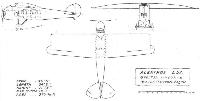
Flight, June 1924
THE THIRD INTERNATIONAL AERO SHOW AT PRAGUE
THE GERMAN EXHIBITS
ALBATROSWERKE, BERLIN-JOHANNISTHAL
<...>
The "L.66" is a type between the low-power sporting type and the light 'plane, as the term is understood in this country. As will be seen from the two views published herewith, the "L.66" is a parasol monoplane two-seater, with a horizontally opposed air-cooled two-cylinder engine mounted in the nose. Simplicity and low cost of production are, obviously, the objects aimed at by the designers, and the result is, as in so many cases where these are first considerations, not particularly pleasing to the eye. It does not, of course, follow that the machine is not quite a good one aerodynamically, although the great amount of strutting employed in attaching the monoplane wing to the fuselage must offer a not inconsiderable resistance. On the other hand, the undivided wing is probably fairly efficient, although the square and very deep wing-tip ribs do not look particularly efficient.
Constructionally the Albatros "L.66" is chiefly remarkable for the fact that, as distinct from all previous Albatros machines, it is largely of metal construction. Hitherto this firm has made rather a speciality of all-wood construction, the Albatros fuselages having been ply-wood covered structures since several years before the War. In the "L.66," however, steel-tube construction has been employed, and welding of struts to longerons, much after the style of the Fokker fuselages. Bracing is by wire, and the covering is ordinary doped fabric.
The two seats are placed side by side, and if it is desired to use the machine for school work the controls can be duplicated. The usual stick and foot-bar controls are fitted, and present nothing out of the ordinary. The rudder and tail skid are, however, interconnected so as to enable the machine to be easily steered when taxying at low speed The power-plant of the machine exhibited was a 30 h.p. Haacke, but other engines can be supplied if desired. The engine is mounted slightly above the nose of the fuselage, and behind it is the oil tank, enclosed in a fairing which carries the instrument - board. The under-carriage is a simple axle with two wheels slung inside the fuselage, through the sides of which the axle projects. Rudder and elevator are both balanced, and there is neither fixed vertical fin nor tail plane.
The monoplane wing, which has a considerable dihedral angle, is of ordinary wood construction, and is, as already pointed out, mounted on a rather elaborate system of struts. The petrol tank is contained in the centre of the wing so as to give direct gravity feed. The ailerons have their leading edge working in a semicircular channel on the rear face of the rear spar. We have not been able to obtain particulars of the overall dimensions of the machine, but when the wing is unshipped and placed along the fuselage the overall dimensions of the machine folded are approximately 5-5 m. (18 ft.) in length; height. 2-2 m. (7 ft. 3 ins); width, 1-2 m. (4 ft.). The weight of the machine empty is 220 kgs. (484 lbs.), and the useful load, consisting of pilot and passenger and 33 litres of petrol, is 175 kgs. (385 lbs.), bringing the total loaded weight up to 395 kgs. (869 lbs.). As the wing area is 13-5 sq. m. (145-5 sq. ft.), the wing loading is just under 6 lbs./sq. ft. The maximum speed is given as 100 km./hrs. (62 m.p.h.), and the climb to 1,000 m. (3,300 ft.) occupies approximately 15 minutes. The duration is three hours at full power.
- Flight, June 1924
THE THIRD INTERNATIONAL AERO SHOW AT PRAGUE
Фотографии
-
Flight 1922-10 / Flight
THE ALBATROS, TYPE L.57 MONOPLANE, ROLLS-ROYCE "FALCON" ENGINE: Three-quarter front view.
-
Flight 1922-10 / Flight
THE ALBATROS L.57: Note how fuselage deck fairing is carried into the curve of the wing.
-
Flight 1923-07 / Flight
Первый авиалайнер фирмы "Альбатрос" L.58
The Albatros "L.58" cabin monoplane: A commercial machine with cantilever wings and a 260 h.p. Maybach M.B.IV, or 260 h.p. Rolls-Royce "Falcon," engine. -
Aeroplane Monthly 1989-03 / J.Stroud - Wings of Peace
An Albatros L 58, probably the prototype.
-
Flight 1920-12 / Flight
AN ALBATROS COMMERCIAL MACHINE : Plan, side and front elevations to scale
- Фотографии




